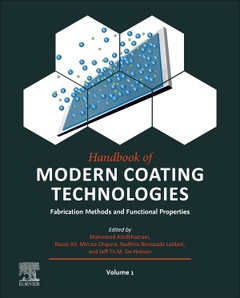Description
Handbook of Modern Coating Technologies
Fabrication Methods and Functional Properties
Coordinators: Aliofkhazraei Mahmood, Nasar Ali, Chipara Mircea, Bensaada Laidani Nadhira, De Hosson Jeff Th.M.
Language: English
Subjects for Handbook of Modern Coating Technologies:
Keywords
Active food packaging; Antimicrobial; Antimicrobial activity; Antistatic; Apatite growth; Atmospheric pressure chemical vapor deposition; Atmospheric pressure deposition; Atomic force microscopy (AFM); Barrier properties; Bifunctional coatings; Bioactive coatings; Block copolymer; Bragg diffraction; CPCD; Cell adhesion; Cellulose derivatives; Chemical vapor deposition; Coating; Coatings; Colloidal crystal coatings; Combustion CVD; Confined-plume chemical deposition; Contact fatigue; Corrosion; Corrosion resistance; Cutting ceramics; Cutting inserts; Cytotoxicity; Deposition on biotissues; Deposition on polymers; Diamond-like carbon; Dome Matrix; Elastomeric modifiers; Electroless; Electron microscopy (TEM; Electrophoretic deposition; Electrospinning; Emulsion polymerization; Epoxy resin; Femtosecond laser; Flame pyrolysis; Fracture strength; Friction; Functional coatings; Functionalized nanocoatings; Graphene oxide; HOS MG63 cells; Hardened steel; Hardener; Hardness; Heat resistance; High-speed friction; Implants; In vivo coating; Langmuir–Blodgett films; Layer morphology; Layered high-strength ceramic; Mass transport phenomena; Mechanical treatment; Metal oxides; Microcrystalline coatings; Microhardness; Microsecond laser; Multilayers; Multiparticulate units; Nanocrystalline structure; Nanofiber; Nanoparticle; Nanosecond laser; Nanosheet; Nanosol; Nanostructures; Ni–B; Noble metals; Optimization; Osseointegration; Physical vapor deposition; Polymer foils; Polymethacrylates; Precursor rate; Preparation; Press coating; Protection; Quantum dots; Reaction kinetics; Roughness; SEM); Self-healing; Severe plastic deformation; Spin coating; Structural colors; Substituted hydroxyapatite; Surface treatment; Suspension stability; Textile modification; Thermodynamics; Tribology; UV protection; Ultimate tensile strength; Wear
554 p. · 19x23.3 cm · Hardback
Description
/li>Contents
/li>Readership
/li>Biography
/li>Comment
/li>
Handbook of Modern Coating Technologies: Fabrication Methods and Functional Properties reviews different fabrication methods and functional properties of modern coating technologies. The topics in this volume consist of nanocoatings by sol?gel processes for functionalization of polymer surfaces and textiles and mechanical fabrication methods of nanostructured surfaces such surface mechanical attrition treatment, polymer nanofabrications and its plasma processing, chemical vapor deposition of oxide materials at atmospheric pressure, conventional chemical vapor deposition process at atmospheric pressure, feasibility of atmospheric pressure, chemical vapor deposition process, Langmuir?Blodgett technique, flame pyrolysis, confined-plume chemical deposition, electrophoretic deposition, in vitro and in vivo particle coating for oral targeting and drug delivery, novel coatings to improve the performance of multilayer biopolymeric films for food packaging, corrosion protection by nanostructured coatings, tribological behavior of electroless coatings, effect of peening-based processes on tribological and mechanical behavior of bioimplant materials, improved efficiency of ceramic cutting tools in machining hardened steel with nanostructured multilayered coatings, incorporation of elastomeric secondary phase into epoxy matrix influences mechanical properties of epoxy coatings, enhancement of biocompatibility by coatings, porous hydroxyapatite?based coatings, and bionic colloidal crystal coatings.
1. Nanocoatings by sol-gel processes for functionalisation of polymer surfaces and textiles
2. Mechanical fabrication methods of nanostructured surfaces such surface mechanical attrition treatment (SMAT)
MPS LTD
3. Polymer nanofabrication and its plasma processing
4. Chemical vapor deposition of nanostructured materials at atmospheric pressure
5. Langmuir-Blodgett Methodology: a Versatile Technique to Build Nanoparticle Films
6. Flame pyrolysis – a cost-effective approach for depositing thin functional coatings...
7. Confined-Plume Chemical Deposition
8. Electrophoretic Deposition: an effective technique to obtain functionalized nanocoatings
9. In vitro and in vivo particle coating for oral targeting and drug delivery
10. Use of electrospun coatings to improve the performance of multilayer biopolymeric films
11. Corrosion protection by nanostructured coatings
12. Tribological Behaviour of Electroless Ni-B Coating
13. Effect of Peening on Tribological and Mechanical Behavior of Bio-Implant Materials
14. Improving the efficiency of the cutting tool made of ceramic when machining hardened steel
15. Incorporation of Elastomeric Secondary Phase into Epoxy Matrix influences Mechanical properties of Epoxy coatings
16. Enhancement of biocompatibility by coatings
17. Bionic Colloidal Crystal Coatings
Surface scienstits and reserach students in the area of nano- coatings and their applications.Chemists, chemical engineers and material scientists as well as coating engineers in industry.
Nasar Ali’s research interests are focused on different coating materials, such as carbon and deposition methods (e.g. CVD, PVD), plasma assisted treatments and nanomaterials. Dr. Nasar Ali has published extensively with over 120 research publications in the field. Dr Ali serves on the editorial board of several nanotechnology related journals, such as Journal of Nanoscience and Nanotechnology, Journal of Nano Research etc. Furthermore, Dr Ali chairs some high profile international conferences such as NANOSMAT and MPA.
Mircea Chipara is Assistant Professor in the Department of Physics and Geology. The research of Dr. Chipara is focused on materials obtained by dispersing nanometer - sized particles with different physical properties (mechanical, optical, thermal, electrical, or magnetic) within polymeric matrices (nanocomposites). Such materials may exhibit multifunctional properties and may present smart capabilities. Due to their low weight and outstanding physical properties, nanocomposites have potential applications as space materials. The research of Dr. Chipara also includes a thorough investigation of the fundamental mechanisms and processes responsible for the degradation of polymers and polymer – based nanocomposites.
Nadhira Laidani is a Senior Scientist and Research Unit leader at the Center for Materials and Microsystems of FBK, Trento, Italy. She received her diploma of “Engineer in Petrochemistry from the National Institute of Hydrocarbons and Chemistry (INHC) of Algiers, Algeria, and her P
- Describes new methods, including plasma-based treatments
- Show properties and mechanisms that can be compared for the industrialization of new methods for specific components with desired properties
- Classifies methods, providing a better understanding of treatments and showing which treatments are possible replacements for conventional methods
- Includes new applications such as chromate plating
- Illustrates new methods and their ability to optimize properties
These books may interest you

Protective Thin Coatings Technology 160.25 €


